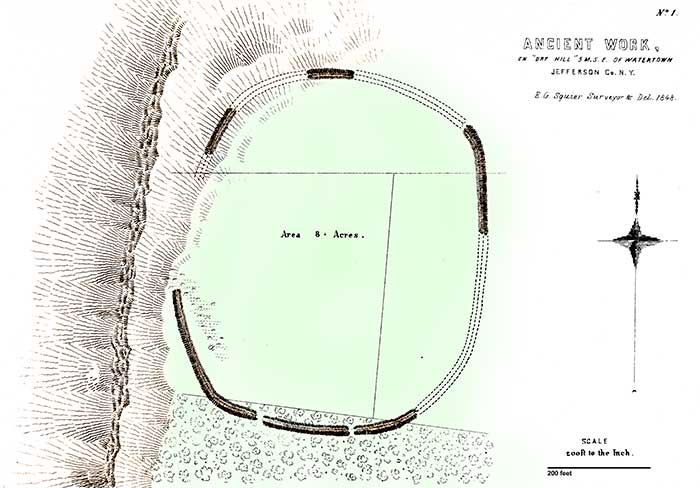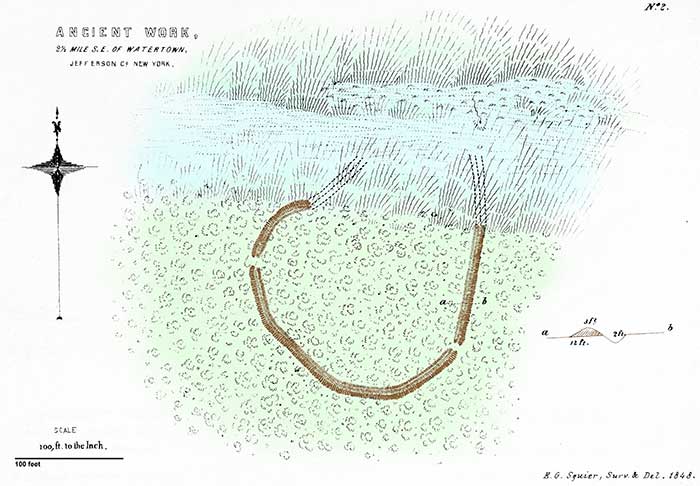
PLATE II. No. 1.
ANCIENT WORK ON "DRY HILL," FIVE MILES SOUTHEAST OF WATERTOWN, JEFFERSON COUNTY, NEW YORK.
FOLLOWING the brow of the terrace northward from the work first described, for about two miles, we come to another work of somewhat more regular figure, and of larger dimensions. Most of it is under cultivation, and the outlines are very much defaced. The embankment, upon one side, runs into the forest land, where it is well preserved, measuring, perhaps, three feet in height. The darker lines of the engraving show what parts are still distinctly marked; the dotted lines those which have been ploughed down, and which are no longer distinguishable from the general level, except by the deeper green and more luxuriant growth of the grass on the line of the ancient trench. The position of the work, it will be seen, corresponds very nearly with that of the one previously described. There is, however, no water near at hand, except a limited supply from a small spring. Nevertheless, this seems to have been the site of a very populous aboriginal town. The entire area of the work is covered with accumulations of carbonaceous matter, burned stones, fragments of bones, pottery, etc. Indeed, these indications are visible for some distance exterior to the walls, upon the adjacent level. These artificial accumulations have rendered the soil within the enclosure extremely fertile, and it sustains most luxuriant crops. In cultivating the area, many fragments of human bones, some of them burned, have been observed,—suggesting the possibility that the ancient village was destroyed by enemies, and that these are the bones of its occupants, who fell in defence of their kindred, and were burned in the fires which consumed their lodges. A little to the northward of the work, there seems to have been an aboriginal cemetery. Here the plough frequently exposes skeletons, buried according to the Indian mode, and accompanied by various rude relics of stone and bone. Within and around the work are also found stone axes, flint arrow-heads, and other remnants of savage art. Fragments of pottery and broken pipes of clay are, however, most abundant. Of these bushels might be collected without much difficulty.
It is clear that this work was not intended as a place of last resort, but was occupied by a considerable population for a long period. It was undoubtedly a fortified town. It should be remarked, that although now nearly or quite filled up, here were originally a number of pits (popularly known as wells) of considerable size, the caches of the ancient occupants.

PLATE II. No. 2.
ANCIENT WORK TWO AND A HALF MILES SOUTHEAST OF WATERTOWN, JEFFERSON COUNTY, NEW YORK.
STILL continuing along the brow of the terrace northward, for two and a half or three miles, we reach a third work, the greater part of which is covered with forest, and is consequently well preserved. It is much smaller than any of those before described, and is bounded by a series of right lines, slightly rounded at the angles, which gives it something of the appearance of a modern field-work. The slope of the terrace bank is here comparatively gentle, and there is a step or table about midway from the brow to the base. Here a number of springs start out, below the stratum of rock. Formerly the walls of the work were continued down the slope, towards the springs, as indicated by the dotted lines in the plan. They are not now to be traced further than the edge of the terrace. The position of this work is remarkably fine, and was selected with taste and skill. The table-land immediately around it is level; the soil gravelly and dry. There seems to have been a burial-place in this vicinity, and pipes and fragments of pottery are of common occurrence. It is to be hoped that the remaining portion of this work will be preserved from the encroachments of the plough.

